In this excerpt from NBA Jam, a book from Boss Fight Books and author Reyan Ali coming in 2018, we learn about the night the development team from Midway let arcadegoers get their hands on their innovative, soon-to-be-legendary basketball game for the first time.
Somewhere along the maroon carpet, between the mirrored walls, among the rows of gleaming screens that lit the room, you could find it: a new arcade cabinet, debuting here tonight at Dennis’ Place For Games in Chicago, Illinois.
At six feet tall and 181kg, the device’s proportions resembled a big refrigerator. Its sides were emblazoned with a basketball’s pebbled orange pattern, the silhouetted logo of the National Basketball Association, and the word “Midway” in fire hydrant red italics. The cabinet housed coin slots, four control panels, speakers, and a 64cm cathode ray tube monitor built to shine day and night. A marquee crowned the machine, announcing its title in all caps: NBA JAM.
But on this early evening in late 1992, those letters sat unlit, the cabinet still unpowered. Customers entertained themselves with other attractions because the Jam machine lacked an essential component: the memory chip containing the game’s code. That piece sat a few miles away at the offices of Williams Bally/Midway.
A titan in coin-operated video and pinball, the company occupied a chunk of real estate on Chicago’s northwest side where it created its products from scratch, from the programming, marketing, and selling of the games to the construction and decoration of their metal-and-wood cases (or “cabinets”). Employees called the operation Williams. The world knew it as Midway.
After spending the past year programming and tweaking — endlessly tweaking — their new take on the basketball video game, the NBA Jam squad made extra last-minute adjustments. Once the code was good enough to go, they burned a fresh memory chip for the machine at Dennis’ Place. Jam was about to move from the cloistered playground of development to the wilderness of public opinion.
When a coin-op game was almost complete, Midway sent a cabinet “on location” or “on test” to a local arcade to get an idea of how much it might make and how many cabinets it should assemble. Chicago had an abundance of spots for consumer feedback. Midway’s Mortal Kombat had recently appeared at Times Square Arcade. NBA Jam‘s future lay in the hands of Dennis’ Place’s customers. All sorts came through the arcade doors: hardcore gamers and schoolchildren, teens and families, hipsters and gangsters alike.
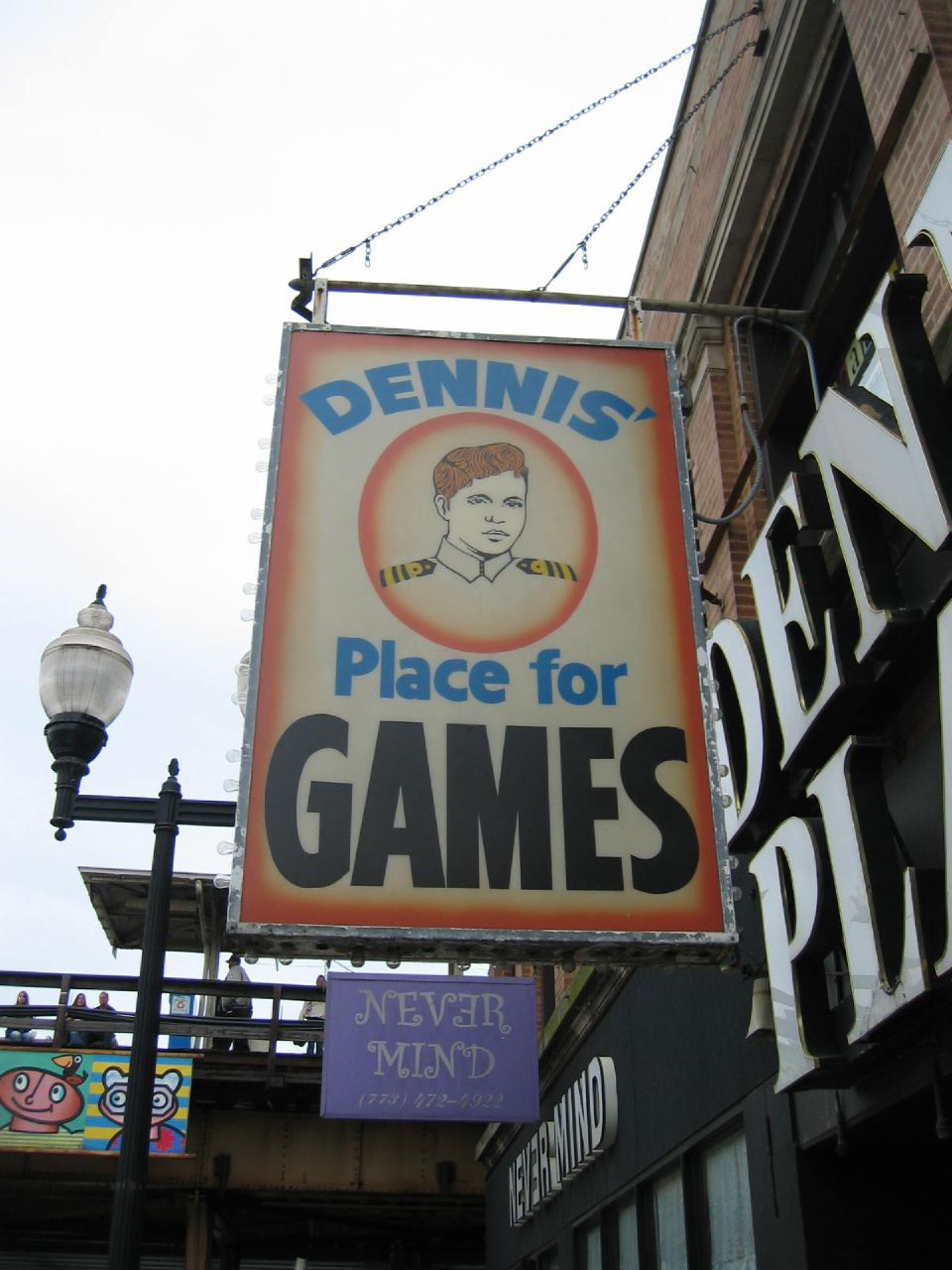
Tucked into a corner across the Belmont red line El stop, Dennis’ Place For Games boasted a large lightbulb-dotted sign. For its logo, a uniformed young man with a shock of neatly parted red hair stood stoically, probably posing for a military portrait. The visual was trustworthy and traditional — the kind of old-world insignia that could go on a bottle of aftershave or a jar of pasta sauce.
The man on the sign, in the name, and on its tokens was Dennis Georges. Born and raised in Greece, where he served in its navy, Georges dreamed of immigrating to America. He arrived in the 1960s and found his calling in the booming storefront video arcade business. In the late 1970s, he opened the first Dennis’ Place For Games in Chicago. He expanded it into multiple locations around the city, but this spot at 957 West Belmont Avenue was the real one.
A black belt in karate and former pro boxer, the middle-aged Georges was friendly but no-nonsense when it came to the rules. His game room prohibited the following: smoking, drinking, eating, loitering, and wearing hats or head coverings. Because his arcade had been held up before, he suspended security cameras and mics from the ceiling. One time, Georges even kicked out Defender creator Eugene Jarvis for banging on a game too hard.
Despite its touches of respectability, Dennis’ Place had a habit of being dirty. Its neighbourhood was rough and heavily trafficked — once the centre of a graffiti scene — but Dennis’ Place made a good spot for keeping kids off the streets as Chicago’s murder rate skyrocketed. Homeless youth would pack the room long past midnight, staying warm in the fluorescent glow.
At Midway, visiting your game for its inaugural night on test was a must. It was a win-win for all involved. Georges would reap the buzz of a brand-new attraction appearing at his business, plus he’d keep whatever money the game generated. Jam’s development team would be able to see how their work held up under public scrutiny and get a chance to spot any bugs or problems.
For their peers at Midway who would join them, it was an opportunity to hang out and root for their friends’ project. The first night’s line-up included, among others, Jam team members Mark Turmell, Sal DiVita, John Carlton, and Jon Hey; Terminator 2: Judgment Day developer George Petro; and finally Defender creator and Midway veteran Eugene Jarvis, whose resume, knowledge, and insight made him the developers’ de facto chief.
Jarvis believed that you could tell how well a game was going to do in its first night out on test, sometimes even within its first hour. The bluntness of Dennis’ customers’ opinions offered a window into how a game would perform on wide release. If an arcade game made it here, its cash box was bound to fill up elsewhere. If it didn’t, the container would remain hollow. A game’s earliest moments alive in the dark were crucial.
Daylight slipping away, the Midway crew trooped over to Dennis’ Place. Their arrival produced zero fanfare. Most people didn’t understand or care who made arcade games. They were only interested in the games themselves, and they were eager to sample Jam. With an audience forming around the machine, Jam artist DiVita popped open the back of the cabinet.
He carefully fit the memory chip’s pins into its sockets, making a little show out of the installation. When finished, he closed up and flipped a switch. Electricity flowed. The letters on the marquee brightened to life. The speakers awoke with a pop. The picture came into focus.
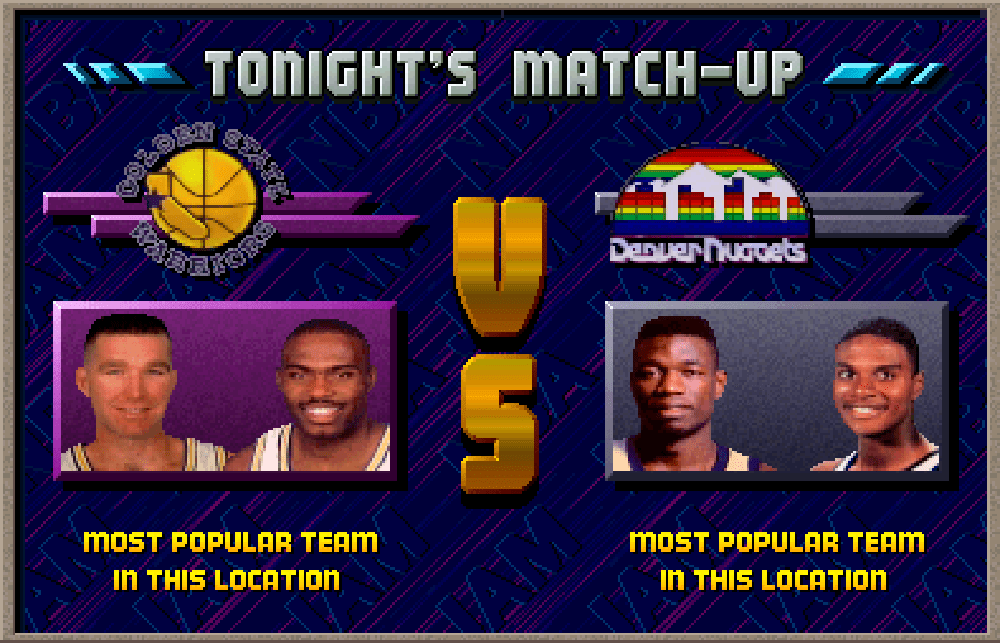
Before anyone could claim a turn, DiVita stood close so the machine could enter “attract mode.” A game’s attract mode was a polished demo sequence consisting of gameplay, high scores, character bios, logos, and other ephemera. When no one was paying to play, it became bait to catch passersby. Letting the attract mode run meant everyone at Dennis’ could get a first look at Midway’s handiwork together.
A virtual arena appeared, stuffed to the rafters with roaring fans. Two teams of two stood on the hardwood, ready to go. At center court, a referee blew his whistle and chucked a ball skyward. A disembodied voice piped up: “Here’s the tip!” Lifelike players galloped across the floor, passing, stealing, blocking, and trading points. The high-contrast colours of their jerseys popped like soda can labels.
While the game’s slick presentation seemed lifted from a television broadcast, the action tapped into athletic fantasy. Shoving wasn’t just allowed — it was encouraged. Fouls were practically nonexistent. Players were full of stamina and could even be boosted with a Turbo button.
The real story was NBA Jam‘s take on the slam dunk. Players routinely leapt heavenward with carefree flamboyance, reaching outrageous altitudes. They pulled off spins, contortions, and cannonballs with acrobatic grace. When they landed at the hoop, the impact was seismic.
Once the on-court demo disappeared, a high score screen lauded the cabinet’s “Greatest Players.” Since this machine didn’t have a scratch on it, Jam listed eight sets of initials by default. Each line represented a man behind the product: “SL” for Shawn Liptak, “RJR” for Jamie Rivett, “SAL” for DiVita, and so on. Video game developers typically worked under a shroud of anonymity, but Midway’s teams were different.
Its personnel plastered their names, faces, and voices wherever they could. Their ambitious, over-the-top work bubbled with Easter eggs, sly remarks, and buckets of personality. Reality bored them. “Exaggerated reality,” on the other hand, was where a video game concept could really take flight.
Over the 80-hour work weeks leading up to the debut at Dennis’ Place, the Jam group pored over their baby. They argued relentlessly over the decisions that shaped the game. Contentious enough points meant yelling and screaming. Chairs might be thrown.
Yet by the same token, they laughed at and cheered on the absurdities of their new realm. They playtested and adjusted the game over and over and over again. Deep into development, they gambled on rounds of Jam. The prizes started out as vending machines snacks. Before long, they were tossing in their own cash over afternoon wars.
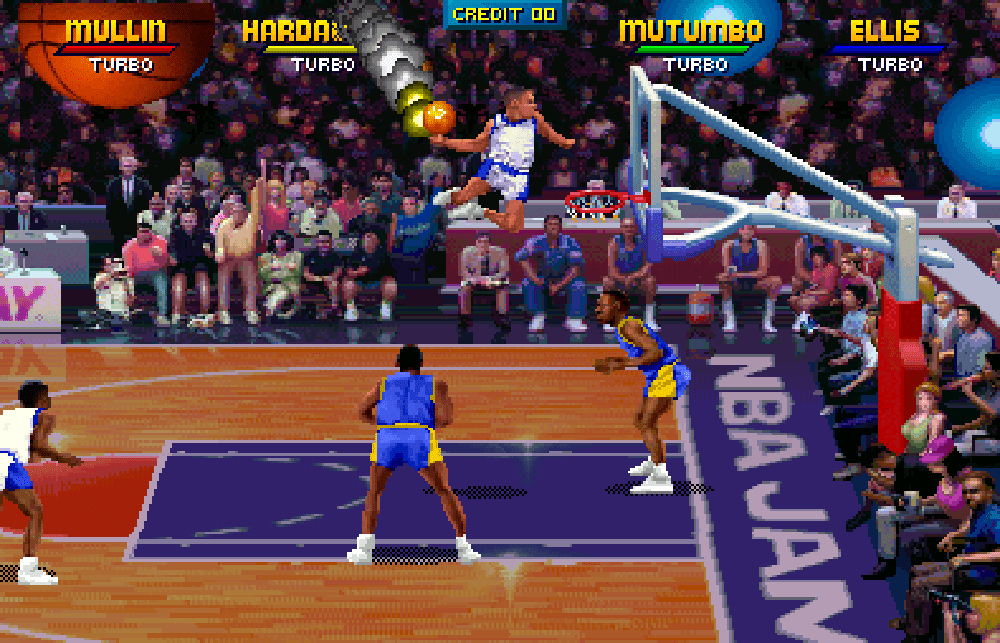
Shimmering atop the Greatest Players roster were the letters “MJT” for Mark Joseph Turmell. Six-foot-four and lanky, with long Robert Plant hair and a passion for mischief, the 29-year-old Turmell was Jam‘s mastermind. As a kid in suburban Michigan, he programmed Apple II games at home and mailed them off to a publisher in California.
In return, he received $US10,000 ($12,676) in monthly royalty checks before he was old enough to buy a pack of cigarettes.
After spending his twenties chasing fortune on the West Coast, he was back in the Midwest to work on the highest tech in video games: coin-op. Smash T.V., his introduction to the arcade, performed well. Its semi-sequel, Total Carnage, was a financial flop. NBA Jam had not been without its troubles — the project almost never secured its crucial licence — but Turmell believed he was onto something huge.
On the flickering screen, the attract mode ran a second roll call. This one was far more recognisable. Headshots and names of NBA stars flew by: Charles Barkley, Shawn Kemp, Hakeem Olajuwon, Scottie Pippen, Reggie Miller, Patrick Ewing, and dozens more. This was another revelation. No previous basketball video game had offered so many familiar NBA likenesses, especially ones that actually resembled the real deal.
If there was ever an ideal time to celebrate basketball in the Windy City, this was it. Led by Michael Jordan, the Chicago Bulls were two-time NBA champions eyeing a third ring. Over the summer, the Dream Team had cruised to Olympic gold. The air was thick with the fever of winning.
A customer approached the NBA Jam machine and fed it its first token. The Midway guys settled in for the evening. Notebooks at the ready, Turmell and DiVita paid close attention to activity on the machine. Grand reactions were Turmell’s lifeblood.
Patron after patron stepped up, drinking in the rules and rhythms of this strange landscape. The excitement was soundtracked by Tim Kitzrow, a local voice actor who contributed to several pinball games. His entry into video required his best Marv Albert impression.
Players in Jam exchanged improbable shots at an impossible pace, but Kitzrow kept up with it all, loudly firing off one one-liner after another.
“From downtown!” “Re-jected!” “The nail in the coffin!” “Jams it in!”
Every play thrilled him. Even amidst the racket of the arcade floor, Kitzrow’s voice carried. Customers quickly took to imitating his inflections as they sank in coin after coin.
“He’s heating up!” “HE’S ON FIRE!” “BOOMSHAKALAKA!”
By 11 o’clock, it became clear that NBA Jam was a hit. The Midway team commemorated the occasion by dipping out for New York-style pizza, making it back to the arcade before close to soak up more feedback. As crowds poured into the streets at 2 a.m., Turmell and company were riding on a high.
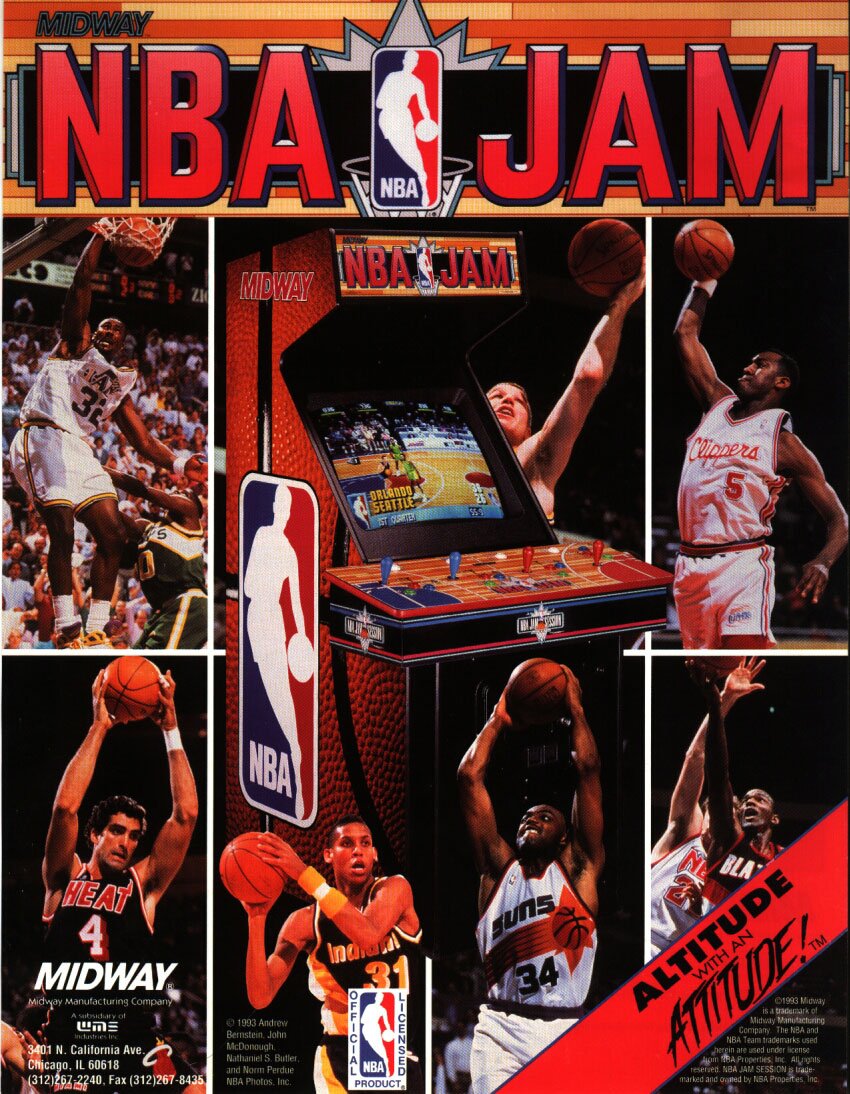
But the work wasn’t done yet. On nights two and three of the test, Turmell and DiVita returned to Dennis’ Place. NBA Jam played well, but they noticed issues with the game.
For example, the presence of real-life NBA players led gamers to instinctively assume they were programmed to emulate their flesh-and-blood counterparts. Maximizing the Utah Jazz’s classic small man/big man combo of John Stockton and Karl Malone appeared to be a smart manoeuvre. “Don’t even put it on the floor next to Stockton,” one customer said to another about the light-fingered point guard. “He’ll take it every time.” The problem was, as Jam artist John Carlton had pointed out, the code never accounted for variation between players.
They were like M&M’s: no matter how different they looked, they were all the same inside. Any difference between Stockton and Malone existed solely in gamers’ imaginations. The Jam team made a note.
A second exchange was harder to watch. One kid coined in, tapped Start on Player 2’s station, and then began playing Player 3’s controls without realising his error. With the wrong joystick and buttons at his fingertips, every motion he made was meaningless. Other players zigzagged after the ball. Player 2 stood off to a side aimlessly.
Turmell preferred to not interfere with customers on test, but this circumstance was special. He introduced himself and explained the mistake. “You’re here on Player 3,” he said. “You’re actually on Player 2.” Embarrassed, the boy thanked him and grabbed the correct controls. Turmell returned to DiVita to commiserate over the awkward user experience. It was a disaster.
Yet not even a minute later, the kid was back on Player 3’s post, doing nothing and loving it. Maybe the problem was with him. Maybe the problem was with the game. Either way, the encounter led the Jam team to add colour-coded instructions that pinpointing the contestants before tip-off. They called them “bozo boxes” or, less kindly, “idiot boxes.”
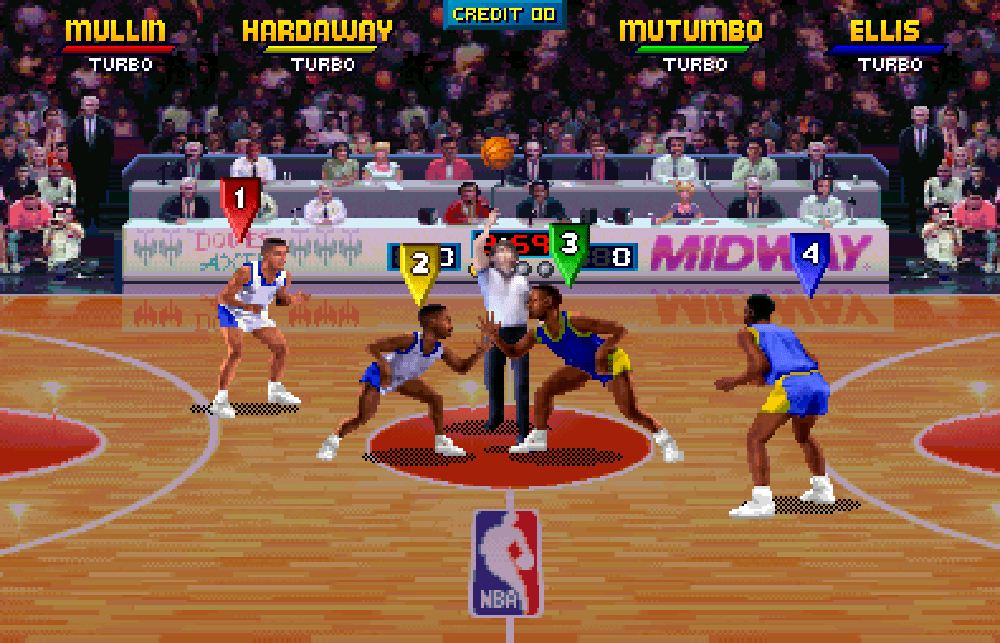
Hour after hour, crowds continued to huddle around Jam. It would take a year for the team to understand just how massive of a phenomena they had birthed. Jurassic Park was 1993’s biggest movie, accumulating $US346 ($439) million within a year. In that same timeframe, NBA Jam tripled it to the tune of over $US1 ($1) billion.
Gamers across the globe perfected Jam techniques and mined for secrets. The game was splashed across magazine covers. It came to be adored by the public, the press, other developers, celebrities, and the real NBA players it sought to capture. NBA Jam resulted in long-distance phone calls, short-distance road trips, and arguments over printer ink. Midway launched an entire division on its back.
When the game was adapted to home consoles — virtually every system available at the time — it blew up all over again. There were updates, sequels, spin-offs, and rip-offs. NBA Jam commercials made it to TV and movie theatre screens. A sprawling cast — politicians, musicians, sitcom stars, quarterbacks, sluggers, dinosaurs, and a parade of unknown programmers and executives — would be enshrined in those future incarnations.
Its influence reverberated in hip-hop, fine art, sneakers, research papers, and real NBA games. It even led to bitter heartbreak for its creators who first witnessed it soar on Belmont Avenue.
But as the opening evenings on test wound down, NBA Jam had not yet conquered the world. It was still a game with a broken feature that demanded an immediate fix.
After seeing the Stockton/Malone debacle, Turmell and DiVita left Dennis’ Place one night and circled back to work. Cutting past the dormant pinball tables and half-built arcade cabinets, they returned to their computers. Under the Utah Jazz’s player portraits on a menu screen, DiVita added tiny text and bars signifying attributes: “Speed,” “3 Ptrs,” “Dunks,” and “Def.” DiVita cranked up Malone’s dunking ability and rendered Stockton lightning fast. Now, they were a one-two punch, just like the real thing. The game’s sense of depth immediately increased.
This was a start. Within hours, it would be light again. Another full day at Midway lay ahead. They would be back in the arcade soon enough.
NBA Jam is be available from Boss Fight Books and Amazon Australia now. This story has been updated since its original publication.
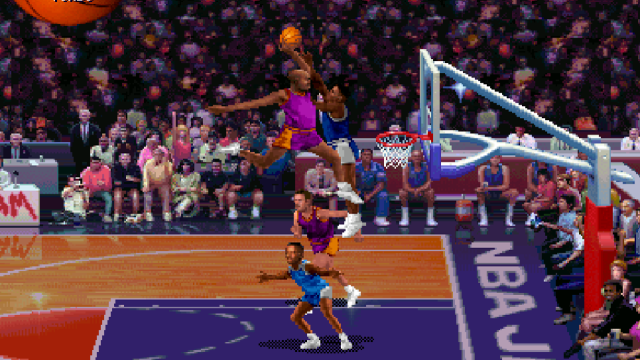
Comments
2 responses to “The Night They Turned On The First NBA Jam Machine”
NBA Jam was awesome. It was the next most played machine for me at the arcades besides Street Fighter 2.
Would have never known they initially designed the game to have all characters the same.
Great story. Thanks.
Boomshakalaka, this was an amazing read. So many good times had playing NBA Jam.
WELCOME TO NBA JAAAM!!!
Dnnt dnnt, dnnt dnnt, dnnt, dada, Dnnnnn dnnt, dnnt dnnt, dada…
24 years later and that tune is still scorched into my brain!
Great story.